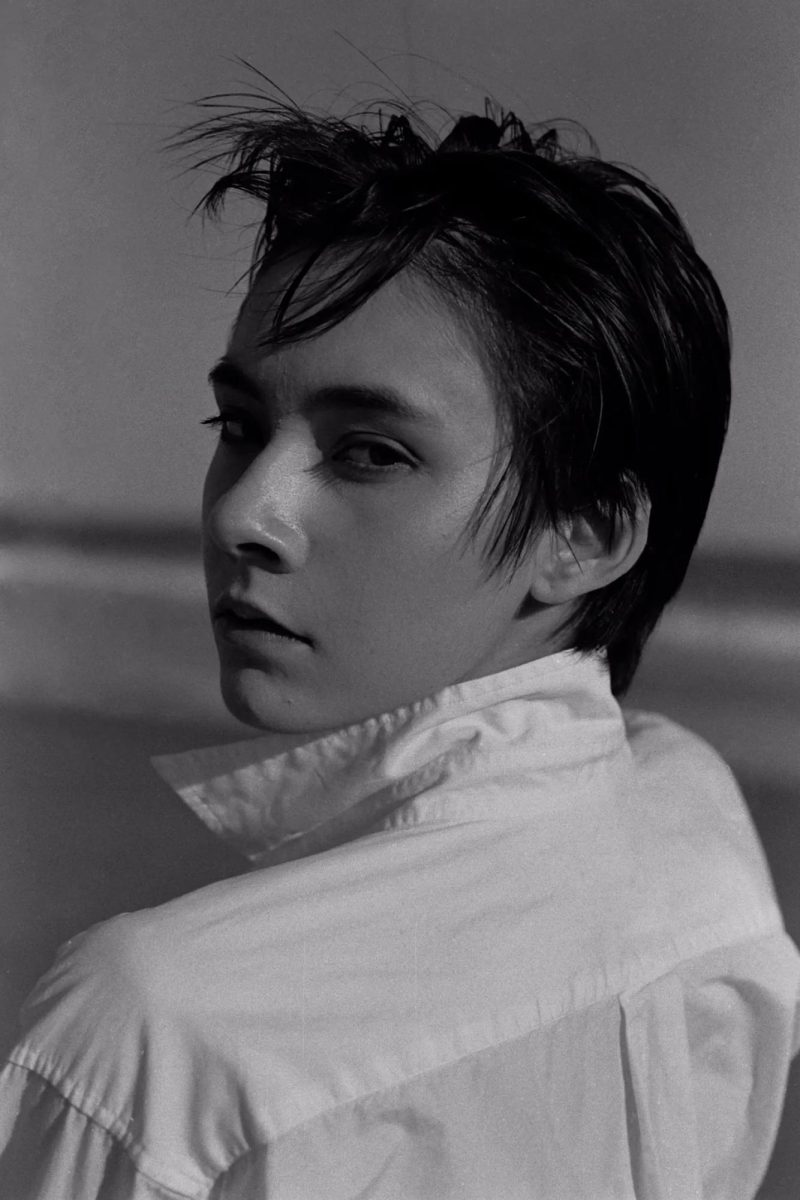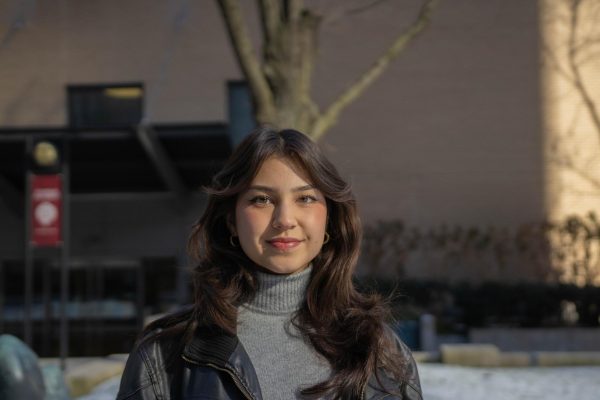New York City is a hotbed for emerging talent in the fashion scene. With its robust history of heavyweight designers and cultural pioneers, the stage is set for the next generation hoping to break new ground. Fordham Lincoln Center is a metropolitan touchpoint for young artists, and among the panoply of students are working models.
Ria Mehrotra
Ria Mehrotra, Gabelli School of Business at Lincoln Center ’26, hails from Baton Rouge, Louisiana and was invited to attend an IMG fashion camp in Florida at the age of 15, where she gained formative experience and exposure to industry leads.
During the pandemic, she landed her first contract after an agency reached out to her over Instagram. She has since moved on to different representation — Stetts Model Management and Natural Model Management in Los Angeles — and works primarily in the commercial sphere for brands such as Adidas, Maybelline, Crocs and more.
“If you told me five to 10 years ago I would be a model, I would have laughed in your face,” Mehrotra said.
But under the steady guidance of her current agency mentors, Mehrotra rejoices in her work. She has always felt an artistic instinct, and loves feeling like a piece of the puzzle when she’s on set with photographers, stylists and other creatives. She described seeing the final product as “a total serotonin surge.”
The rewards don’t come without taxation, however. Mehrotra is a full-time marketing student, and juggling academics with work can be exhausting. For her, balance is about knowing how to divide and conquer. She said that stacking her classes on specific days of the week gives her the availability on her days off to focus solely on modeling.
No matter the hurdles, finishing her degree remains an integral goal.
“If you told me five to 10 years ago I would be a model, I would have laughed in your face,”Ria Mehrotra, Gabelli School of Business at Lincoln Center ’26
Laurie Paul
Mehrotra’s friends believe her job is glamorous — a common misconception, she noted. Laurie Paul, Fordham College at Lincoln Center (FCLC) ’27 and a rising model, affirms this sentiment.
“It’s hard work, it’s constant work,” they said. “It’s staying aware of what’s happening on social media, it’s reading, it’s being ready to go at the drop of a hat.”
Paul is a fresh face on the modeling scene, having worked locally in San Jose, California before coming to Fordham this fall. She is now represented by two New York City based agencies and has hit the ground running.
“I really didn’t know where it was going to go when I started,” Paul said. “I found that I both took well to being on camera and just really enjoyed it.”
While Paul dreams of walking for the luxury Italian fashion house Moschino, they are currently focused on building their portfolio and having fun with it. Paul remarked light-heartedly on their tiny McKeon wardrobe that their off-duty clothes are often shoot clothes. They’ve curated their style to work in both domains, accruing timeless basics with personal flair.
Despite having just started her career, Paul is acutely aware of the time constraint on modeling. Getting her degree in art history will ideally provide some security if and when she needs to switch lanes. It’s also a subject that she’s deeply interested in, however, and becoming a museum curator is something she has kept on her radar after learning of the profession in high school.
“It’s hard work, it’s constant work. It’s staying aware of what’s happening on social media, it’s reading, it’s being ready to go at the drop of a hat.” Laurie Paul, FCLC ’26
Hilda Yi
This kind of dual pursuit is a part of a new modeling culture, according to Hilda Yi, FCLC ’26. Yi began modeling in middle school in South Korea, after a hairdresser shared photos of her two-toned look on social media and one connection led to another. She has a lot of editorial experience under her belt, and was featured in a spread for Dazed Magazine Korea.
“Before, it was like, you want to be a model and that’s it,” she said. “But the thing is, you can’t sustain yourself, it’s not regularly paid. The models I meet — they always have something else to offer.”
The artistry at the core of the work was a major draw for Yi. However, her current contract is ending soon and she’s considering her options.
“I do not think of myself as ending in modeling,” she said. “To me, it’s always been a side thing. It’s not the whole of me.”
Yi is studying sociology, with a minor in film and television. She is interested in the research side of social science, and acknowledged how different that is from her modeling work. Human connection and group interaction are fascinating to her.
Yi shared that she might take a short break after her contract expires and reflected on the absurdity of modeling as a constant performance.
“It’s a very weird job. Some people wouldn’t even call it a job. You have to control your face, you have to control every action you do, because now it’s not even about you being on set — it’s about persona,” Yi said.
The obligation to uphold a particular image on set and off can be discomforting. Yi said that people tell her she’s an extrovert, which she noted she is reluctant to embrace. For Yi, it’s hard to discern whether her sociable disposition was a natural development of her personality, or a byproduct of working in front of the camera and striving to stand out at castings.
On the whole, modeling standards have come under public scrutiny in the past few years. Calls for diversity have placed pressure on major companies and agencies to keep up with the changing cultural climate. Victoria’s Secret (VS), the lingerie titan whose “Angels” were the face of stereotypical bombshell sex appeal, ditched their outdated branding in 2021. Their current approach celebrates a broader range of body types, and they’ve recruited new ambassadors that represent female success stories.
Mehrotra noted that these kinds of changes are promising. She mentioned Paloma Elsesser, a size 14 model at the forefront of the VS renaissance, as someone who is breaking boundaries.
She also said she admires the integrity of her two agencies, who both “strive to have diverse boards and models as part of their teams.” To her, these are demonstrable signals of improvement.
The commercial world is undoubtedly ahead, but critics argue that this overhaul has just barely moved the needle on deeply ingrained beauty standards. High fashion is a seemingly indomitable reminder of those long standing ideals.
“I think I’ll be the most radical one,” Yi said, laughing. “There’s no progress. I think the biggest misconception is maybe that.”
Yi acknowledged that trends do change, citing the current demand for multiracial models as an example. Certain expectations, however, are unwavering.
“You’re an ethnically ambiguous model, but then it’s like, ‘what size are you?’” Yi said. “The standards stay the same.”
She pulled back slightly, admitting that social media has allowed for all different kinds of people to have a spotlight. Even still, Yi believes this is somewhat disillusioning. Social media isn’t representative of the whole industry, she claimed, given that less executive oversight is required for individuals to post on public platforms.
Across the board, Mehrotra, Paul and Yi agree that the modeling world is evolving rapidly. Paul mentions Tokyo and Brazil as two burgeoning scenes to keep an eye out for. Mehrotra emphasized the increasing overlap between modeling and other creative professions, such as styling and creative directing.
When it comes to haute couture — the exclusive custom-made clothing of prominent luxury fashion houses and designers — they all observe Europe’s reputation steadily surpassing that of New York.
“Now what happens is, (models) go to Milan or Paris first,” Yi said, referring to the designer runway circuit. “They go to New York later on, where things are a little more commercial, a little less avant-garde.”
As social media and technological advancements threaten to disrupt the exclusivity of legacy fashion houses, the future of the field appears uncertain. This won’t stop the nascent generation from pursuing their dreams and seizing a new definition of success.
“There are a lot of working models whose names you’ll never know, but whose faces you’ll see dozens of times,” Paul said. “Just do the best you can, work hard. And if you know you’ve done the best you can, and that some of it is up to chance, it’s easier to face all the pressure.”


